Finally eating enough and having an apartment, these were the wishes of the post-war period. Normality should begin again - after the war, after the period of economic and political uncertainty.
The dream of the good life
A new decade begins:The 1950s go down in the history of the Federal Republic as the decade of the economic miracle. It will last until the mining crisis of the early 1960s.
Ludwig Erhard, pioneer of currency reform and the Federal Republic's first economics minister, set the course. "Social market economy" is the name of the new economic order. "Prosperity for everyone" - that was the slogan of the CDU before the federal elections in 1957 - should bring this form of economy. Everyone who achieves something should also be able to afford something.
The promotion of industry stands at the beginning of the economic upswing. Mining and the steel industry are established as the basis and energy suppliers, later mechanical engineering, the chemical and electrical industries gain in importance.
However, the production of consumer goods for private use did not play a major role in the first half of the 1950s. Wages also grew only slowly at first, and companies' profits flow into further expansion.
The fact that the Federal Republic recovered so quickly from the aftermath of the war is mainly due to the support of the Western Allies. In the Cold War they need a strong ally at the interface of the blocs. Instead of accepting further dismantling, the Federal Republic of Germany benefits from the "Marshall Plan", the reconstruction aid from the USA for the war-ravaged European countries.
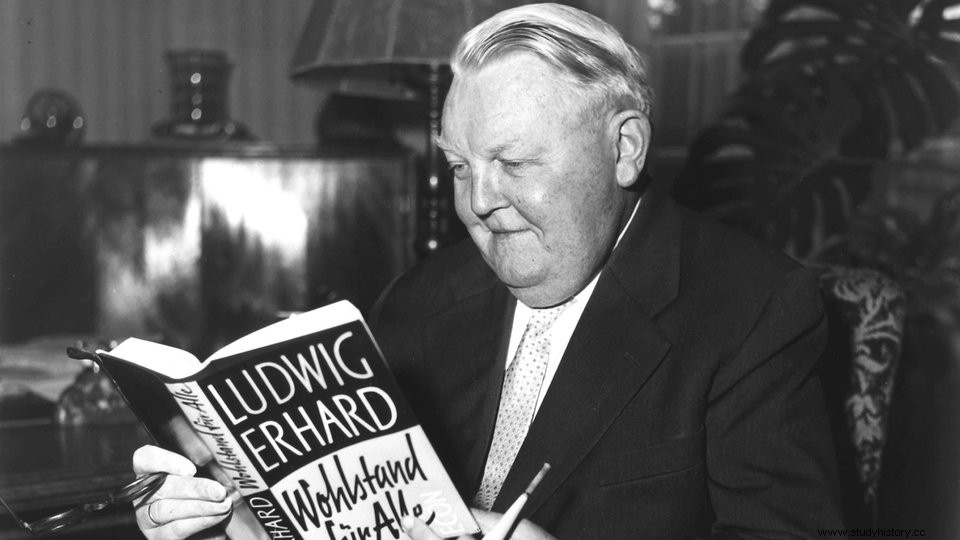
Ludwig Erhard is considered the architect of the economic miracle
Full employment
In the years 1950 to 1963, industrial production increased by 185 percent in real terms. There is enough work force, the numerous displaced persons and refugees can be put to good use in building up the economy.
However, women who worked in many areas of the economy at the end of the war and in the first few years afterwards are sent back home. The Adenauer government's image of women and families only allows women to work until marriage.
At the end of the 1950s there was even a shortage of workers. Entrepreneurs begin to hire foreign workers. The first recruitment agreement with Italy was signed in 1955, followed by other Mediterranean countries from 1960:Portugal, Spain, Greece and Turkey.
The word "guest workers" comes from the fact that the recruitment does not provide for the workers brought into the country to stay permanently. In 1964, the millionth guest worker is welcomed at Cologne Central Station. Mostly they work as unskilled workers in factories and on construction sites, later mainly in mining, even if they had learned other trades at home.
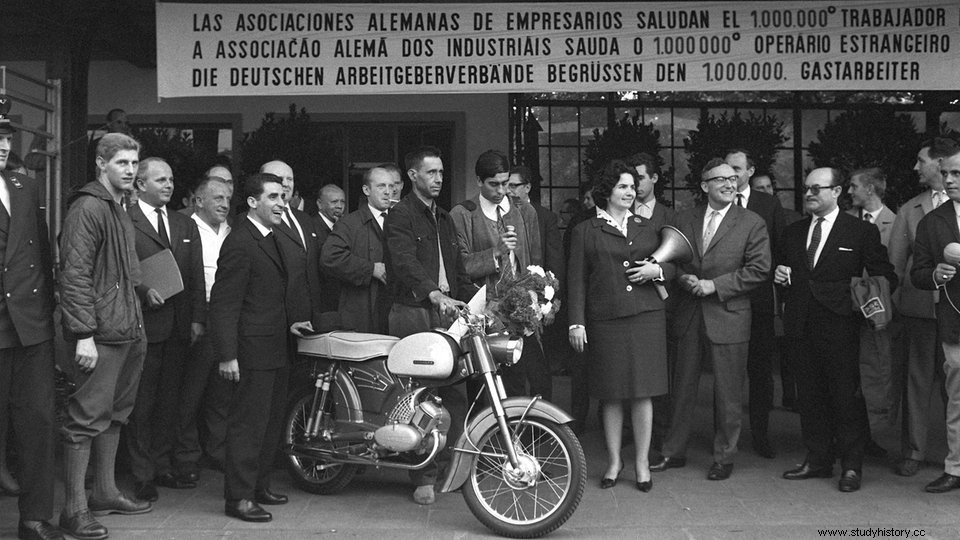
The millionth guest worker gets a moped in 1964
"Made in Germany"
The VW Beetle becomes a symbol of the economic miracle. The millionth copy rolled off the production line as a gold-plated special model in 1955 at the Wolfsburg plant.
The electrical sector is also booming:washing machines, refrigerators, televisions and radios are best sellers. Companies like Krupp, which had fallen into disrepute through armaments production in the Second World War, were badly damaged by bombs and dismantled after the end of the war, recover in the 1950s.
Locomotives, industrial plants, machines and engines are sold all over the world. The Federal Republic as an industrial location attracts many investors from abroad - foreign trade is flourishing. "Made in Germany" becomes a mark of quality for export goods.
Ludwig Erhard has always resisted the term "economic miracle", as he saw the economic rise of the Federal Republic as a result of hard work, reconstruction work and - in the first few years - the renunciation of the fulfillment of personal consumer needs. Not as a miracle that had come overnight.
Through the development of the economy, the Federal Republic is also regaining the esteem of other countries with which the relationship was shattered by the war. The West Germans are gaining a new sense of national pride without having been preceded by a detailed political debate about the war and National Socialism.
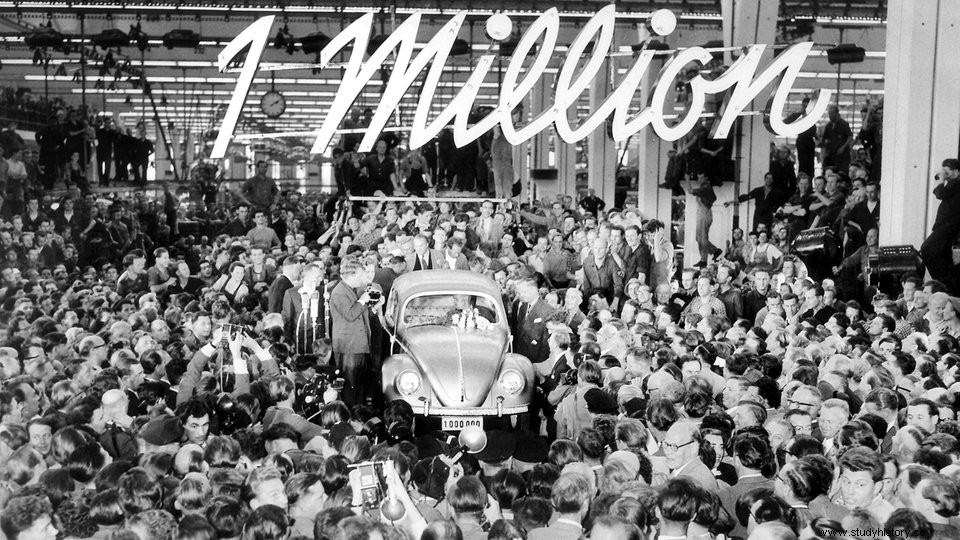
The VW Beetle became a bestseller
Consumption and wealth
From the mid-1950s, private purchasing power also increases while the cost of living stagnates. So there is more money left over for consumption. The Germans go on a real spending spree:furniture, cars, travel, electrical appliances. Ludwig Erhard's concept of "prosperity for all" seems to be working.
The mass production of consumer goods makes the prices of formerly unaffordable things like radios, televisions or washing machines cheaper. The federal government supports the dream of a "little house in the countryside" with low-interest construction loans.
Everyone has a share in the growing prosperity:including the workers and – after a pension reform in 1957 – the elderly. Social security, full employment - in the 1950s, the standards for a quality of life were formed that are now taken for granted.
Two manifestations of the desire to consume are the "fretting wave" and the new desire to travel. After the war, the main concern was to get enough to eat, but in the 1950s many Germans gorged themselves on "affluent bellies". Good butter, real bean coffee - sumptuous food is in demand.
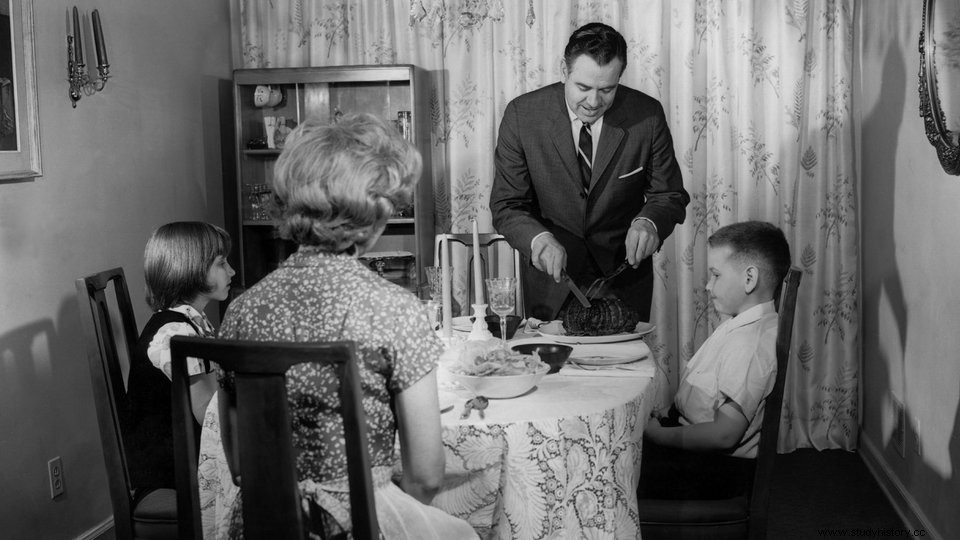
The Sunday roast was a must in the 1950s
Little by little, eating habits are also changing:the light wheat flour, formerly reserved for cakes, is being baked more and more for bread – the Americans have shown the way with their toast. Preserves and frozen foods are replacing fresh vegetables from our own garden. Travel makes you want exotic food.
Traveling in general:In the 1950s, vacationing seemed to be once again becoming a possibility for many Germans. Initially, West Germans mainly visit relatives, later they move into boarding houses and hostels.
In the early 1960s, every third German went on vacation once a year. Even if the wanderlust is great - Italy remains a dream for most. The travel destinations are initially still nearby:the North Sea coast, low mountain ranges such as the Sauerland, the Black Forest or Bavaria. Bus companies also offer trips for those who cannot yet afford their own car.
And car owners are discovering a new, inexpensive holiday option:camping. From the mid-1960s, the first travel companies fly regularly to "Mallorca – the German barbecue in the Mediterranean" (according to the text of a television report from 1965).
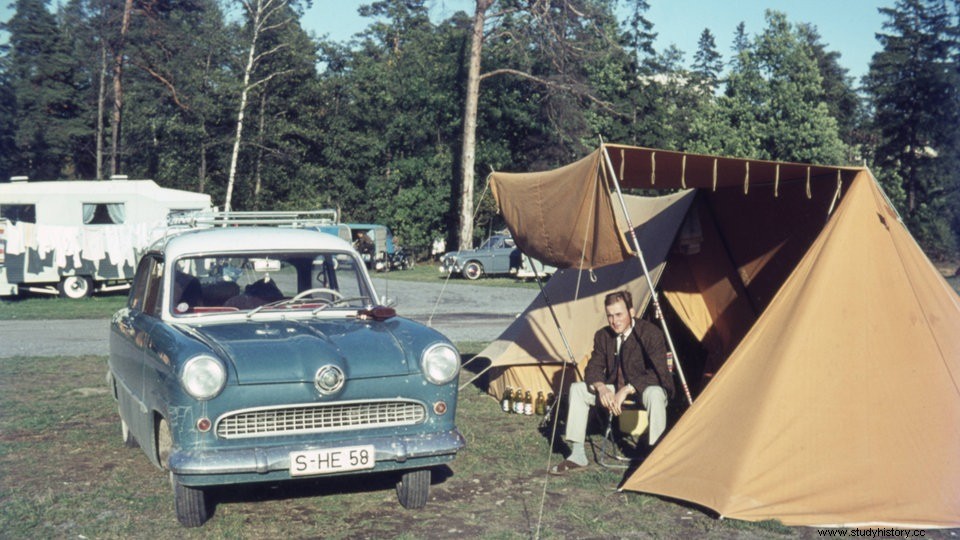
With car and tent on holiday
